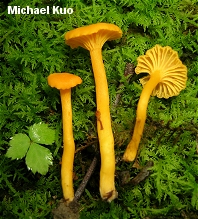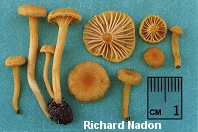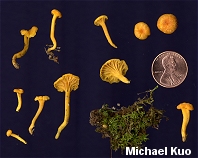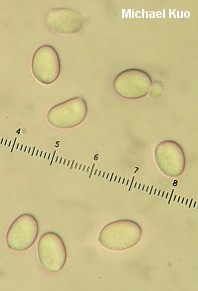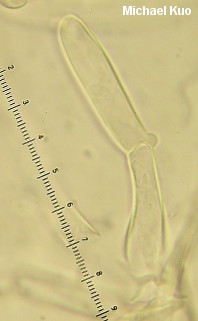| Major Groups > Chanterelles and Trumpets > Cantharellus minor |

|
Cantharellus minor [ Basidiomycota > Cantharellales > Cantharellaceae > Cantharellus . . . ] by Michael Kuo Other than size, there isn't much separating this mushroom from species in the Cantharellus cibarius group--and, to complicate things, miniature forms of cibarius-like species can be found with some regularity, if my own experience is indicative. However, Cantharellus minor usually grows in moss and is not only much smaller than the average chanterelle, but has more slender proportions. The hollowing stem of Cantharellus minor is very slender, and much longer than the width of the cap--and the cap is insubstantial rather than fleshy. The cap does not, however, usually develop a central perforation and become deeply vase-shaped, like the caps of Craterellus ignicolor. Petersen (1979) describes a hemlock-associated form of this species from Great Smoky Mountains National Park, Cantharellus minor f. intensissima, which "differs in its brilliant orange coloration and usually copiously anastomosing lamellar folds." Description: Ecology: Mycorrhizal with oaks and other hardwoods; growing alone, scattered, or occasionally gregariously in moss; late spring through fall; widely distributed east of the Rocky Mountains. The illustrated and described collections are from Illinois, Indiana, and Québec. Cap: 5-20 mm across; broadly convex when young, becoming planoconvex or shallowly depressed, with an arched and wavy margin; not developing a central perforation; egg-yolk yellow to orange-yellow or orange; bald and often somewhat waxy; dry or slightly moist. Undersurface: With well developed false gills that run down the stem and are distantly spaced; colored like the cap or slightly paler. Stem: 10-40 mm long; 1-3 mm wide; slender; equal or tapering slightly to base; becoming hollow; bald; colored like the cap or paler. Flesh: Insubstantial; yellowish to orangish. Odor and Taste: Taste not distinctive; odor not distinctive, or slightly sweet and fragrant. Chemical Reactions: Iron salts negative on flesh and undersurface. Spore Print: Pale yellowish. Microscopic Features: Spores 8-11 x 5-7 µ; ellipsoid; smooth; inamyloid; slightly ochraceous in KOH; contents minutely granular. Basidia 2-6-sterigmate; 55-75 µ long. Elements from cap surface 4-12.5 µ wide; cylindric; septate; clamped; hyaline in KOH; walls about 1 µ thick; terminal cells subclavate or cylindric with rounded apices. REFERENCES: Peck, 1872. (Saccardo, 1887; Corner, 1966; Petersen, 1976; Bigelow, 1978; Smith, Smith & Weber, 1981; Phillips, 1991/2005; Lincoff, 1992; Metzler & Metzler, 1992; Barron, 1999; Roody, 2003; McNeil, 2006; Miller & Miller, 2006; Buyck et al., 2010; Kuo & Methven, 2014.) Herb. Kuo 07140301, 05260403, 07050702, 06140901. This site contains no information about the edibility or toxicity of mushrooms. |
© MushroomExpert.Com |
|
Cite this page as: Kuo, M. (2015, March). Cantharellus minor. Retrieved from the MushroomExpert.Com Web site: http://www.mushroomexpert.com/cantharellus_minor.html |
